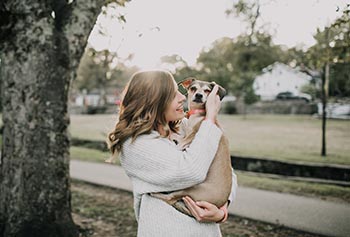HOW CAN WE HELP?
6a - 7p Monday - Friday
6a - 2p Saturday
Mountain Time
PHONE
1-877-738-7237
FAX
1-866-777-1434
MAIL
Pets Best
2323 S Vista Ave. Ste. 100
Boise, ID 83705
My Question
First Name
Last Name
Policy (optional)
Phone
Best Day
Best Time
- Pet Insurance
- Blog
- Senior Pets: Trouble Rising, Stiffness, Limping, and Arthritis

While cats and dogs often remain puppies at heart, age can take a toll on your senior cat or dog. In addition to losing a bit of the spring in its step, senior pets, just like humans, are at higher risk for disease and will most likely experience a normal decline in senses including their sight, hearing and smell. We all know that our pets age more quickly than humans because of shorter life expectancy, but with a good balance of diet and exercise, there’s no reason that your senior dog or cat can’t remain healthy and happy as a senior citizen.
Changes in Mobility
As your dog or cat gets older, you may notice less playing and perhaps your pet takes a bit longer to get up from a nap. Dogs are less interested in chasing squirrels and cats no longer dash around the room. As with any change in behavior, particularly with senior pets, it is important to determine if the change is natural or due to an injury or medical condition that requires attention. Quite commonly, older pets simply slow down. Also, older pets tend to gain some weight, which can also reduce mobility. One symptom that usually requires attention, however, is when your senior dog or cat starts limping or displays signs of chronic stiffness. A limp, or lameness, can be a symptom of trauma or a disease such as arthritis or infection. If you do observe limping, or other signs that mobility is compromised such as difficulty rising up or maneuvering stairs, you should restrict your pet’s movement until your pet can be examined.
Limping, Strains, and Broken Bones
When a pet suddenly starts limping, or shows signs of lameness, the condition could be mild or severe. Also, the limping can appear suddenly or progress more slowly. Mild lameness could last less than 24 hours while severe lameness will be chronic. A mild sprain can result in mild lameness and may disappear within 24 hours with rest. However, if limping persists, your veterinarian can determine if your senior pet is limping due to a strained muscle, joint or something more serious. If your pet cannot tolerate any weight on a limb and seems to be in pain, then you should seek immediate medical attention to ensure that there are no broken or fractured bones. Other reasons for sudden limping or limited range of motion could be a bruise, inflammation, nerve injury or more serious disease such as cancer. Most importantly, if your senior pet is limping, you should consult a veterinarian to ensure that your dog is not in pain.
Symptoms of Arthritis
Limping, however, is often the most common symptom of arthritis and it may be more or less noticeable depending on the time of day and activity. Arthritis is common in older dogs, and less common in cats. In older cats, however, arthritis commonly affects the elbow joint. Sometimes early detection of arthritis is difficult which results in the joints becoming badly damaged before treatment can begin. In addition to limping, other symptoms of arthritis include general difficulty in moving, lethargy, weight gain, incontinence, irritability, swelling of joints, muscle atrophy and excessive licking, chewing or biting the painful areas. Cats, however, do not always display limping, so be aware of other symptoms such as hiding, stiffness, loss of appetite, decreased grooming, accidents outside the litter box and sleeping more than usual.
Treating Pets with Arthritis
If you suspect your senior pet has arthritis, your veterinarian will complete an exam and take x-rays. A variety of treatments will be available to manage pain and reduce inflammation. Treatment options include medication, cortisone or steroids, acupuncture, and physical therapy. Your veterinarian may also recommend changes to diet and exercise regime as well as supplements and additives such as glucosamine, chondroitin, antioxidants and the omega-3 fatty acid. Each pet will respond different to treatment and your veterinarian will advise you of possible side effects as well.
Of course, as pets get older, their bodies naturally become weaker which may result in your senior pet being less physically active then before. As with all aspects of your pet’s health, be proactive and maintain a lifestyle that promotes good habits and health. Encourage your senior pet to exercise with regular walks and appropriate play to stay flexible and hopefully maintain muscle. Senior pets may need more time to get going in the mornings after a long period of rest, so be patient and encourage your dog to stretch and take it easy. Your veterinarian can recommend exercises or massage to help your senior pet’s joints and muscles which can be a fun activity for you to share. With proper diet, exercise and care, senior pets can remain healthy, happy and active for many years.